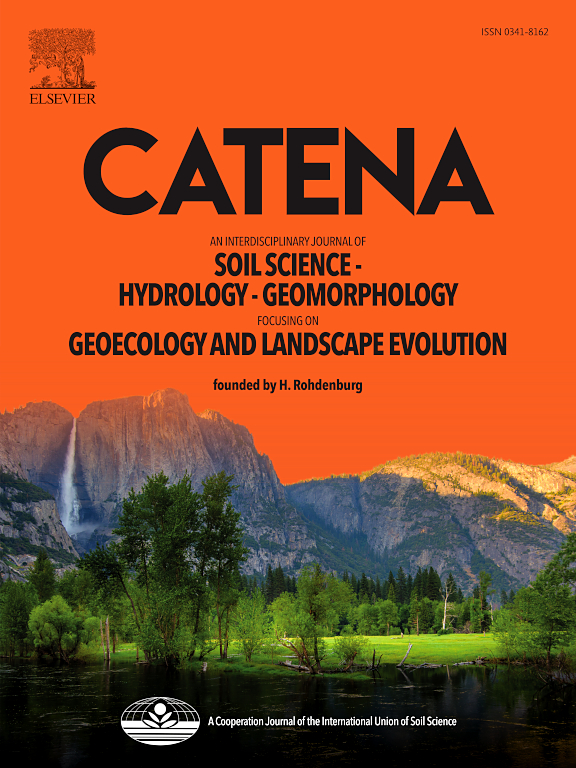Planet SuperDove与精细Sentinel-2影像融合对农田土壤有机碳预测的意义
IF 5.7
1区 农林科学
Q1 GEOSCIENCES, MULTIDISCIPLINARY
引用次数: 0
摘要
当来自多源的高空间和高光谱分辨率的RS图像被整合在一起时,生成的图像被认为可以提供更高的空间、光谱和时间分辨率。尽管图像融合技术已被应用于许多其他领域,但其在土壤科学中用于估计土壤性质(包括土壤有机碳(SOC))的适用性仍然有限,特别是在使用机器学习算法(MLA)的数字土壤制图(DSM)模型的情况下。本研究探讨了利用图像融合技术,将PlanetScope SuperDove (PSD)获取的光谱能力较低的高空间分辨率图像与Sentinel-2 (S2B)卫星的高光谱分辨率图像进行整合,从而提高其光谱能力的可行性。主要目的是利用STRM DEM的融合数据和地形特征来评估大型、多样化和可侵蚀农田的SOC预测性能。分别使用数据集、融合数据集以及使用或不使用STRM数据集建立预测模型。采用了正则化随机森林(RRF)和高斯过程回归(GPR)两种MLAs。在将S2B波段与测量的SOC值合并之前,进行相关性和均匀性检验,以获得用于栅格融合方法的精细化S2B数据。结果表明,采用GPR模型对土壤有机碳含量进行综合预测,RMSE最低为3.3 gkg-1, R2最高为0.83,MAE最高为3.6 gkg-1。在SOC空间分布图上,采用GPR模型补充STRM数据的融合数据集优于其他融合数据集。综上所述,本研究强调了高空间和光谱遥感图像融合对土壤有机碳估算模型的改进潜力,该模型具有在可蚀耕地区广泛应用的潜力。本文章由计算机程序翻译,如有差异,请以英文原文为准。
Significance of Planet SuperDove and refined Sentinel-2 imagery fusion for enhanced soil organic carbon prediction in croplands
When RS images from multisource specifically at high spatial and spectral resolution, are integrated, the generated imagery is believed to provide higher spatial, spectral, and temporal resolutions. Though image fusion techniques have been employed in many other fields, their applicability in soil science for the estimation of soil properties, including soil organic carbon (SOC), remains limited, especially where digital soil mapping (DSM) models using machine learning algorithms (MLA) are employed. This study explores the viability of enhancing the spectral capability of high spatial resolution imagery acquired from the PlanetScope SuperDove (PSD), which has low spectral capability, by integrating it with high spectral resolution imagery from the Sentinel-2 (S2B) satellite through an image fusion technique. The main aim is to use the fused data and topographic features from the STRM DEM to assess the predictive performance of SOC across large, diverse, and erodible cropland. Prediction models were established using the data sets separately, fused, and with or without the STRM data. Two MLAs were used, including regularised random forest (RRF) and Gaussian process regression (GPR). Correlation and homogeneity tests were conducted between the S2B bands and measured SOC values before their incorporation to obtain refined S2B data for the raster fusion approach. The results show that the optimal SOC content prediction comprised the incorporation of STRM data to the fused data, as input, using the GPR model, where the lowest RMSE of 3.3 gkg-1, the highest coefficient of determination (R2) of 0.83, and the MAE of 3.6 gkg-1 were obtained. In terms of SOC spatial distribution map, the fused datasets supplemented by STRM data employing the GPR model performed better than the other alternatives. In summary, this study highlights the promising potential of image fusion of high spatial and spectral RS images to improve the estimation model of SOC, which has the potential to be widely implemented in erodible cropland area.
求助全文
通过发布文献求助,成功后即可免费获取论文全文。
去求助
来源期刊

Catena
环境科学-地球科学综合
CiteScore
10.50
自引率
9.70%
发文量
816
审稿时长
54 days
期刊介绍:
Catena publishes papers describing original field and laboratory investigations and reviews on geoecology and landscape evolution with emphasis on interdisciplinary aspects of soil science, hydrology and geomorphology. It aims to disseminate new knowledge and foster better understanding of the physical environment, of evolutionary sequences that have resulted in past and current landscapes, and of the natural processes that are likely to determine the fate of our terrestrial environment.
Papers within any one of the above topics are welcome provided they are of sufficiently wide interest and relevance.
 求助内容:
求助内容: 应助结果提醒方式:
应助结果提醒方式:


